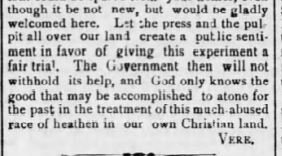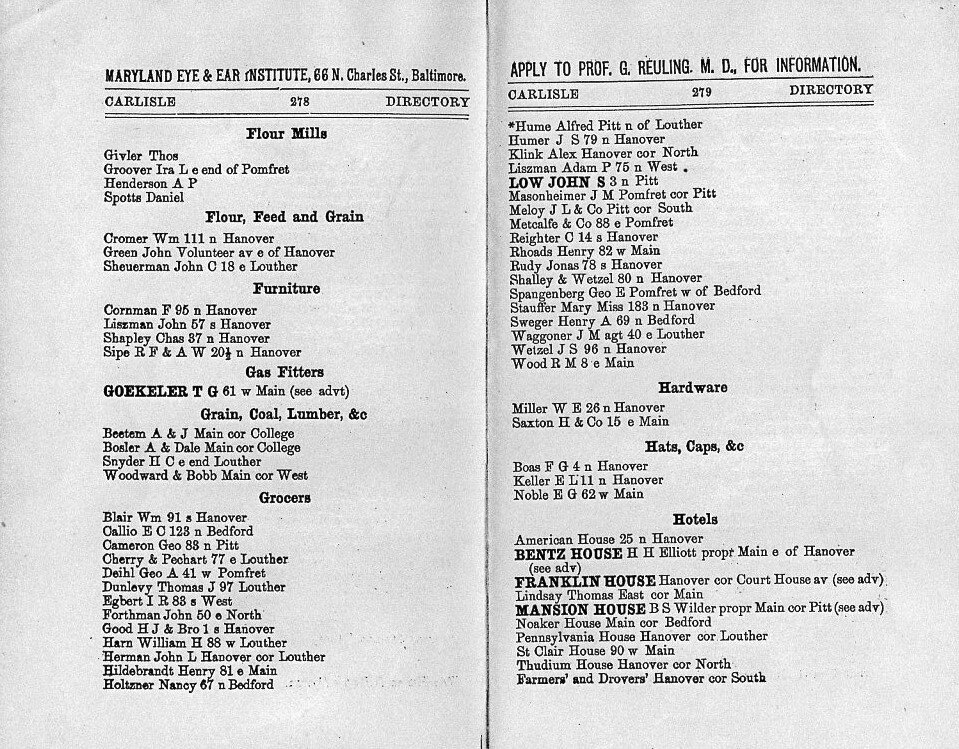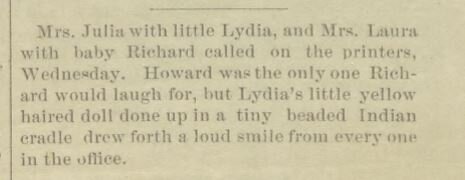Mr. Kemp says that Ulysses Paisano is going to make a first-class harness maker.
The Indian Helper, Vol. V, No. 48, Friday August 1, 1890, p. 3. http://carlisleindian.dickinson.edu/sites/all/files/docs-publications/IndianHelper_v05n48.pdf
I’m not sure whether or not Ulysses’ training as a harness maker would have made it less likely for him to have gone out on an outing—which were often, but not always, to farms. As I learn more about outings, I might be able to see a pattern for this kind of thing.
So Ulysses leaves in 1891. But, as we’ve seen in previous episodes, the student newspapers function like alumni magazines, sharing news as former students—usually good news that reflects well on the school. Here’s what we know about Ulysses’ later life.
A friendly letter from Ulysses Paisano says he has just returned to his home in Laguna, N.M., from a trip to the Rockies where they got lumber for building a new house. We are glad to hear that he is well enough to husk corn all day long.
The Indian Helper, Vol. VII No. 10, Friday November 13, 1891, p. 2. http://carlisleindian.dickinson.edu/sites/all/files/docs-publications/IndianHelper_v07n10.pdf
Well enough? Oh, yes, look at his information card. He left because of illness.
It is said that Ulysses Paisano is married and leading a busy life among his people, the Lagunas of New Mexico.
The Indian Helper, Vol. VIII No. 19, Friday January 27, 1893, p. 2. http://carlisleindian.dickinson.edu/sites/all/files/docs-publications/IndianHelper_v08n19.pdf
A business letter from William Paisano , of Laguna, N.M., gives the gratifying news that his brother Ulysses, who used to be our little Ulysses, has sowed more wheat than any other man of his village this year. Their Governor Santiago died recently.
The Indian Helper, Vol. VIII, No. 29, Friday April 7, 1893, p. 2. http://carlisleindian.dickinson.edu/sites/all/files/docs-publications/IndianHelper_v08n29.pdf
“Our little Ulysses.” So, back up to my comments about how young I thought he looked in that photo—maybe he was acknowledged to be small for his age? Seems like a probable explanation to me.
Ulysses Paisano writes for the HELPER to be sent to him in New Mexico, and his friends will be glad to learn of his existence.
The Indian Helper, Vol. XII No. 16, Friday, January 29, 1897, p. 3 http://carlisleindian.dickinson.edu/sites/all/files/docs-publications/IndianHelper_v12n16.pdf
A Wolf Hunt
A wolf found its way to the Laguna, New Mexico, farms and did much damage among the horses, cattle and sheep, William Paisano writes. So William and several others started out on a fierce hunt for the animal. They found it after having chased several miles on horse back, then Ulysses Paisano, (We all remember Ulysses) got ahead of the others and, being a good marksman hit the wolf. William says that he wife Mary is well, and they send best wishes to all their friends.
The Red Man and Helper, Vol. XVI, No. 46, Friday May 17, 1901, p. 3.
http://carlisleindian.dickinson.edu/sites/all/files/docs-publications/RedMan-Helper_v01n42_1.pdf
Bessie Gotholda
Bessie’s first letter since her return to New Mexico is full of interest. […] Ulysses Paisano is doing a wonderful work among our people, preaching to them and telling them about our Heavenly Father.
We have a prayer meeting every week and services on Sunday morning, and prayer meeting in the evening.
Last Sunday morning the people down where Ulysses lives had service in the morning, and we had ours in the afternoon. A great many people belong to church.
The Red Man and Helper, Vol XVII, No. 6, Friday August 9, 1901, p.2. http://carlisleindian.dickinson.edu/sites/all/files/docs-publications/RedMan-Helper_v02n02_1.pdf
Back from the West
Mr. Siceni Nori, class of ’94 Assistant Clerk to Mr. Bietzel, has returned from New Mexico, where he went a short time since, to take the body of Charles Paisano.
The errand was a sad one, and threw its shadow over his visit to his old home. He talked freely to our reporter, who gave us the following interview. […]
Can you give me the names of our old students who are doing well?
“Nearly all are doing exceedingly well, There are Ulysses and William Paisano, Charles Carr, Walter Analla, Charles Kieh; perhaps the most well-to-do of all is John Chavis. Two are employed in the Locomotive Works in Albuquerque—Samuel Keryte and Paul Shattuck.”
The Red Man and Helper, Vol. XVIII No. 6, Friday August 22, 1902, p. 2. http://carlisleindian.dickinson.edu/sites/all/files/docs-publications/RedMan-Helper_v03n02_0.pdf
Charles Paisano was 14 on arrival and 18 when he died. His school records show his contact (usually a parent) as Martine Paisano, Records show he “died at country home” of “cholera morbus” but the cause is also listed as appendicitis in the Death Record. Note that Siceni was the winner of the sack race described above.
Ulysses and William Paisano both have stores and big trade.
The Arrow, Vol. III No. 3, Friday September 14, 1906, p. 2. http://carlisleindian.dickinson.edu/sites/all/files/docs-publications/Arrow_v03n03.pdf
Carlisle Graduates in Business for Themselves
[…] Among the Pueblos at Casa Blaca in New Mexico, William H. Paisano has a very good store where merchandise is furnished to his fellow tribesmen, the Pueblos. Mr. Paisano obtained his education at Carlisle. He has eighty head of cattle, conducts a good farm, and has been postmaster since 1906. He has been a governor of the pueblo, and has a nice family. His wife is also a returned student from Carlisle. They have a two-story home, which is well-furnished and is splendidly kept. His brother, Ulysses Paisano, who is also a Pueblo, has a larger store with a more complete stock, and is a very prominent man in tribal affairs. The establishment which Ulysses conducts is attractive in its appearance and thorough in the methods of business. One is surprised on entering this store, situated on a reservation miles away from any white settlers, to see the neat arrangement of the goods on shelves, to find additional stock in well-kept warehouses, and to note the cleanliness of the surrounding premises. These two Indians, each in business for himself, are leaders in their community and fine types of the educated Indian.
The Red Man, Vol. 4, no. 7, March 1912, p. 278-279. http://carlisleindian.dickinson.edu/sites/all/files/docs-publications/RedMan_v04n07c.pdf
Notes About Ex-Students
William Paisano was recently re-elected governor of his tribe, the Pueblos. Mr. Paisano is also post-master at Casa Blanca, N. Mex., and has lately been appointed to present his people at Washington, D.C., in a business proposition connected with their land. He left for that city on the 1st of February with his two interpreters, both former Carlisle students, Ulysses G. Paisano and Yamie Leeds
The Carlisle Arrow, Vol. IX, No. 26, February 28, 1913, p. 1. http://carlisleindian.dickinson.edu/sites/all/files/docs-publications/CarlisleArrow_v09n26.pdf
So that’s what we know so far from the materials available online at the Carlisle Indian School Digital Resource Center. We can’t say for sure whether or not Ulysses went on any outings. We can only say that so far we haven’t found any evidence. But, then again, there are still those ledgers that haven’t been transcribed yet. There may be something there. Or, like many Carlisle students, there may be a lot of some kinds of information and not enough of what we’d like to see. I’ll keep this post updated over time if we learn more. Thanks for listening/reading!
So, here’s the update: What my husband (Jim Gerencser, Co-Director of the Carlisle Indian School Digital Resource Center at Dickinson College) pointed out was a bone-headed mistake on my part. Ulysses does have the other kind of card. It is in his student file. Here it is:




![[Sorry, the bottom line of this column was cut off.]](https://images.squarespace-cdn.com/content/v1/5992f9fe37c581f4bd00b989/1614091468448-58WHFG33ZLEWVLPFO6Z1/Newark+1.JPG)












!["The 'Parish Register' of St. John's [Episcopal] Church, Carlisle, Pennsylvania, from 1793 to 1881-2.," pp.208-209.](https://images.squarespace-cdn.com/content/v1/5992f9fe37c581f4bd00b989/1585939486122-BLXDC1F8KNYB8Q2RAH8N/Picture1.jpg)



















![Ulysses Paisano and John Shiosee [?], December 1887. National Anthropological Archives, Smithsonian Institution, NAA 73699; Photo Lot 81-12 06847300. http://carlisleindian.dickinson.edu/images/ulysses-paisano-and-john-shiosee-1887](https://images.squarespace-cdn.com/content/v1/5992f9fe37c581f4bd00b989/1574174791726-98OZFWOQZEVFX25BN65L/NAA_73699.jpg)


















